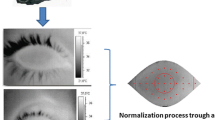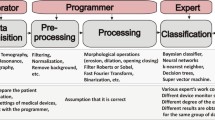Abstract
Functional infrared (IR) imaging is widely adopted in medical field nowadays, with more emphasis on breast cancer and ocular abnormalities. In this article, an algorithm is presented to accurately locate the eye and cornea in ocular thermographic sequences, which were recorded utilizing functional infrared imaging. The localization is achieved by snake algorithm coupled with a newly proposed target tracing function. The target tracing function enables automated localization, allows the absence of any manual assistance before the algorithm runs. Genetic algorithm is used to perform the search for global minimum on the function to produce desired localization. On all the cases we have studied, in average the region encircled by the algorithm covers 92% of the true ocular region. As for the non-ocular region covered, it only accounts for less than 5% of the encircled region.







Similar content being viewed by others
References
Holmberg, A., The temperature of the eye during application of hot packs and after milk injections. Acta Ophthalmol. (Copenhagen) 30(4):347–364, 1952.
Tan, J. H., Ng, E. Y. K., Acharya, U. R., and Chee, C., Infrared thermography on ocular surface temperature: A review. Infrared Phys. Technol. 52:97–108, 2009.
Fatt, I., and Forester, J. F., Errors in eye tissue temperature measurements when using a metallic probe. Exp. Eye Res. 14(3):270–276, 1972.
Rosenbluth, R. F., and Fatt, I., Temperature measurements in the eye. Exp. Eye Res. 25(4):325–341, 1977.
Efron, N., Young, G., and Brennan, N., Ocular surface temperature. Curr. Eye Res. 8(9):901–906, 1989.
Tan, J.-H., Ng, E. Y. K., Acharya, U. R., and Chee, C., Study of normal ocular thermogram using textural parameters. Infrared Phys. Technol. 53(2):120–126, 2010.
Morgan, P. B., Soh, M. P., and Efron, N., Corneal surface temperature decrease with age. Contact Lens Anterior Eye 22(1):11–13, 1999.
Purslow, C., Wolffsohn, J. S., and Santodomingo-Rubido, J., The effect of contact lens wear on dynamic ocular surface temperature. Contact Lens Anterior Eye 28:29–36, 2005.
Chiang, H. K., Chen, C. Y., Cheng, H. Y., Chen, K.-H., and Chang, D. O., Development of infrared thermal imager for dry eye diagnosis, in Proceedings of SPIE—The International Society for Optical Engineering, San Diego, CA, USA, 2006.
Alio, J., and Padron, M., Normal variations in the thermographic pattern of the orbitoocular regionocular region. Diagn. Imaging 51(2):93–98, 1982.
Morgan, P. B., Soh, M. P., Efron, N., and Tullo, A. B., Potential applications of ocular thermography. Optom. Vis. Sci. 70(7):568–576, 1993.
Acharya, U. R., Ng, E., Yee, G., Hua, T., and Kagathi, M., Analysis of normal human eye with different age groups using infrared images. J. Med. Syst. 33(3):207–213, 2009.
Tan, J. H., Ng, E. Y. K., and Acharya, U. R., Detection of eye and cornea on IR thermogram using genetic snake algorithm, in 9th International Conference on Quantitative Infrared Thermography, Krakow, Poland, 143–150, 2008.
Tan, J. H., Ng, E. Y. K., and Acharya, U. R., Automated detection of eye and cornea on infrared thermogram using snake and target tracing function coupled with genetic algorithm. Quantitative InfraRed Thermography International Journal 6(1):21–36, 2009.
Kass, M., Witkin, A., and Terzopoulos, D., Snakes: active contour models. Int. J. Comput. Vision 1:321–331, 1988.
Xu, C., and Prince, J. L., Snakes, shapes, and gradient vector flow. IEEE Trans. Image Process. 7(3):359–369, 1998.
Schindler, K., and Suter, D., Object detection by global contour shape. Pattern Recognit. 41(12):3736–3748, 2008.
Montanari, U., On the optimal detection of curves in noisy pictures. Commun. ACM 14(5):335–345, 1971.
Martelli, A., Edge detection using heurisitic search methods, 1972.
Blake, A., and Yuille, A. (Eds.), Active vision. MIT, Cambridge, 1992.
Menet, S., Saint-Marc, P., Medioni, and G., B-snakes: Implementations and applications to setero, in Proc. DARPA Image Understanding Workshop. Pittsburgh, PA, 720–726, 1990.
Staib, L. H., and Duncan, J. S., Parametrically deformable contour models, in Proc. Computer Vision and Pattern Recognition, San Diego, CA, 1989.
Cohen, L. D., and Cohen, I., A finite element method applied to new active contour models and 3D reconstruction from cross sections, in IEEE Computer Society Conference, Osaka, Japan, 587–591, 1990.
Liang, J., McInerney, T., and Terzopoulos, D., United snakes. Med. Image Anal. 10(2):215–233, 2006.
Tan, J. H., Ng, E. Y. K., Acharya, U. R., and Chee, C., Automated study of ocular thermal images: Comprehensive analysis of corneal health with different age group subjects and validation (accepted), Digital Signal Processing, 2010.
Mori, A., Oguchi, Y., Okusawa, Y., Ono, M., Fujishima, H., and Tsubota, K., Use of high-speed, high-resolution thermography to evaluate the tear film layer. Am. J. Ophthalmol. 124(6):729–735, 1997.
Author information
Authors and Affiliations
Corresponding author
Rights and permissions
About this article
Cite this article
Tan, J.H., Ng, E.Y.K. & Acharya U, R. An Efficient Automated Algorithm to Detect Ocular Surface Temperature on Sequence of Thermograms Using Snake and Target Tracing Function. J Med Syst 35, 949–958 (2011). https://doi.org/10.1007/s10916-010-9552-6
Received:
Accepted:
Published:
Issue Date:
DOI: https://doi.org/10.1007/s10916-010-9552-6




